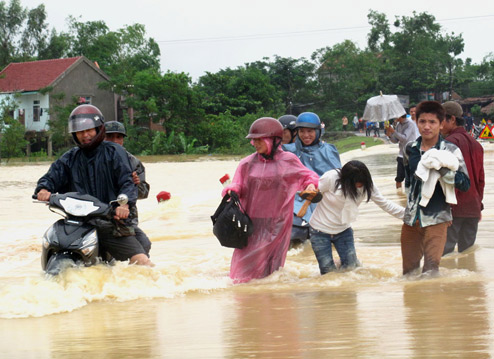You are here
As a result of climate change, experts say storms likely to get worse and more erratic.
Primary tabs
The Mekong Delta floods each year and small children travel to school by boat. Typhoons and tropical storms blow across the South China Sea to the central coast, often on course from the Philippines. Rains flood the cities and thousands of motorbike exhaust pipes choke on the murky water. But the floods that hit the north-central coast of Vietnam in October 2010 were outside the normal pattern.

What initially looked like an unremarkable depression on satellite maps wound up dropping 80 percent of Ha Tinh province's average annual rainfall in just 10 days. Close to 200 people died in these and later floods. More than 250,000 houses were submerged.
Major floods are usually prefaced by a storm. These weren’t. Few had the opportunity to move their belongings to higher ground. Many were trapped on rooftops without food or water for days. Reports by aid groups detailed stories of costly hospital equipment ruined and pregnant women giving birth in attics.
And this likely won’t be a one-off event.
According to experts, unpredictable weather patterns seem to be on the rise in Vietnam. The country will need to adapt, they say, or face increased losses of agriculture, infrastructure and overall GDP.
“If you look at last year and this year what we saw were a succession of medium-scale storm events that affected the country and they also came towards the latter part of the year, which is unusual,” said Ian Wilderspin, a senior technical adviser of disaster risk management at the U.N. Development Program.
“This is now the new norm and the sort of thing we can expect to see recurring. [We have to] gear up for the unpredictability of these events. ... Better preparedness and timely and effective early warnings are needed," he said.
October's floods weren't the first time weather had taken a sporadic turn in Vietnam.
Typhoon Ketsana hit Vietnam in September 2009, killing more than 100 people and doing more damage than any other recent storm.
North Vietnam's worst drought in a century began around this time last year. The Red River, which runs through Hanoi, reached its lowest level in at least 101 years, when records were first taken. Empty hydro dams meant blackouts persisted throughout a very hot summer.
Vietnam has been named among the 12 countries most at risk for climate change by the World Bank, and many experts say climate change is to blame for the growing number of severe, erratic weather occurrences there.
“Natural disasters and other extreme climate events will become more complicated,” said Hoang Minh Hien, an expert in atmospheric physics and satellite meteorology. He added that he expects storms to increase in severity and number, as well as become more unpredictable, as a result of climate change.
Sea level rise is usually touted as Vietnam’s main concern; a one-meter rise would submerge 40 percent of the country and render millions homeless. Much of the country’s key rice-growing areas — Vietnam is the world’s second largest rice exporter, after Thailand — would flood, and people would be pushed into the cities, putting tremendous strain on already limited resources.
Storms and floods cost more than lives, says Miguel Coulier, who works in disaster risk management at the U.N. Development Program.
“It’s been said it’s [storms and flooding costs] 1 percent of GDP a year. ... We have to wait until the end of this year to calculate it,” Coulier said.
Many in the international community believe Vietnam has responded quickly to threats, some would argue the nation leads the region in some areas of response.
A response program implemented in 2008 lays out the responsibilities of each government department and requests all cities and provinces to begin devising climate-change action plans. Tangential but important issues, such as health and food security or the well-being of possibly more-affected groups, such as women and children, have also been addressed.
Vietnam has been “fast in picking up the issue,” said Coulier, but “knowledge of it is limited" among the rural population. "People ... are very aware of how disasters have changed in severity. They don’t know what is happening or talk in climate change language. … but they know things are happening,” he said.
Nguyen Thanh Hoa, a resident of Quang Tri province, one of the five provinces most affected by October’s floods, said that floods and storms have worsened in recent years. He blames deforestation and overflowing dams.
“The levels of flooding and storms have increased rapidly in recent years. We can’t predict it,” he said.
In October, he said the floods caught nearly everyone offguard. They came overnight, he said, so most people weren't able to evacuate.
“Transportation and evacuation during the heavy floods was especially dangerous as the waters rose at night,” he said.
Source: dantrinews/GlobalPost



Recent Comments